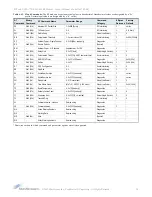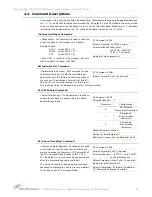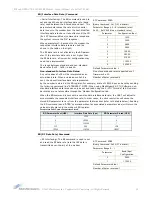
9XTend
‐
NEMA™
RS
‐
232/485
RF
Modem
–
Product
Manual
v2.x4x
[2007.01.04]
©
2007
MaxStream,
Inc.,
Confidential
&
Proprietary
‐
All
Rights
Reserved
15
3.1.3. Flow Control
Figure
3
‐
02. Internal
Data
Flow
Diagram
(The
five
most
commonly
‐
used
pin
signals
shown)
DI (Data In) Buffer and Flow Control
When serial data enters the modem through the DI pin (Data In), the data is stored in the DI
Buffer until it can be processed.
When the RB and RO parameter thresholds are satisfied (refer to ‘Transmit Mode’ section for more
information), the modem attempts to initialize an RF connection. If the modem is already receiv-
ing RF data, the serial data is stored in the modem's DI Buffer. The DI buffer stores at least 2.1
KB. If the DI buffer becomes full, hardware or software flow control must be implemented in order
to prevent overflow (loss of data between the host and RF modem).
How to eliminate the need for flow control:
Two cases in which the DI Buffer may become full and possibly overflow:
Hardware Flow Control (CTS). When the DI buffer is 17 bytes away from being full; by default,
the modem de-asserts CTS (high) to signal to the host device to stop sending data [refer to FT
(Flow Control Threshold) and CS (GPO1 Configuration) Commands]. CTS is re-asserted after the
DI Buffer has 34 bytes of memory available.
Software Flow Control (XON). XON/XOFF software flow control can be enabled using the FL
(Software Flow Control) Command. This option only works with ASCII data.
DO (Data Out) Buffer
When RF data is received, the data enters the DO buffer and is sent out the serial port to a host
device. Once the DO Buffer reaches capacity, any additional incoming RF data is lost. The DO
buffer stores at least 2.1 KB.
Two cases in which the DO Buffer may become full and possibly overflow:
Hardware Flow Control (RTS). If RTS is enabled for flow control (RT Parameter = 2), data will
not be sent out the DO Buffer as long as RTS (GPI1) is de-asserted.
Software Flow Control (XOFF). XON/XOFF software flow control can be enabled using the FL
(Software Flow Control) Command. This option only works with ASCII data.
1. Send messages that are smaller than the DI buffer size. The size of the DI buffer varies
according to the packet size (PK parameter) and the parity setting (NB parameter) used.
2. Interface at a lower baud rate (BD parameter) than the RF data rate (BR parameter).
1. If the serial interface data rate is set higher than the RF data rate of the modem, the
modem will receive data from the host faster than it can transmit the data over-the-air.
2. If the modem is receiving a continuous stream of RF data or if the modem is monitoring
data on a network, any serial data that arrives on the DI pin (Data In) is placed in the DI
Buffer. The data in the DI buffer will be transmitted over-the-air when the modem no longer
detects RF data in the network.
1. If the RF data rate is set higher than the interface data rate of the modem, the modem will
receive data from the transmitting modem faster than it can send the data to the host.
2.
If the host does not allow the modem to transmit data out from the DO buffer because of
being held off by hardware or software flow control.






























